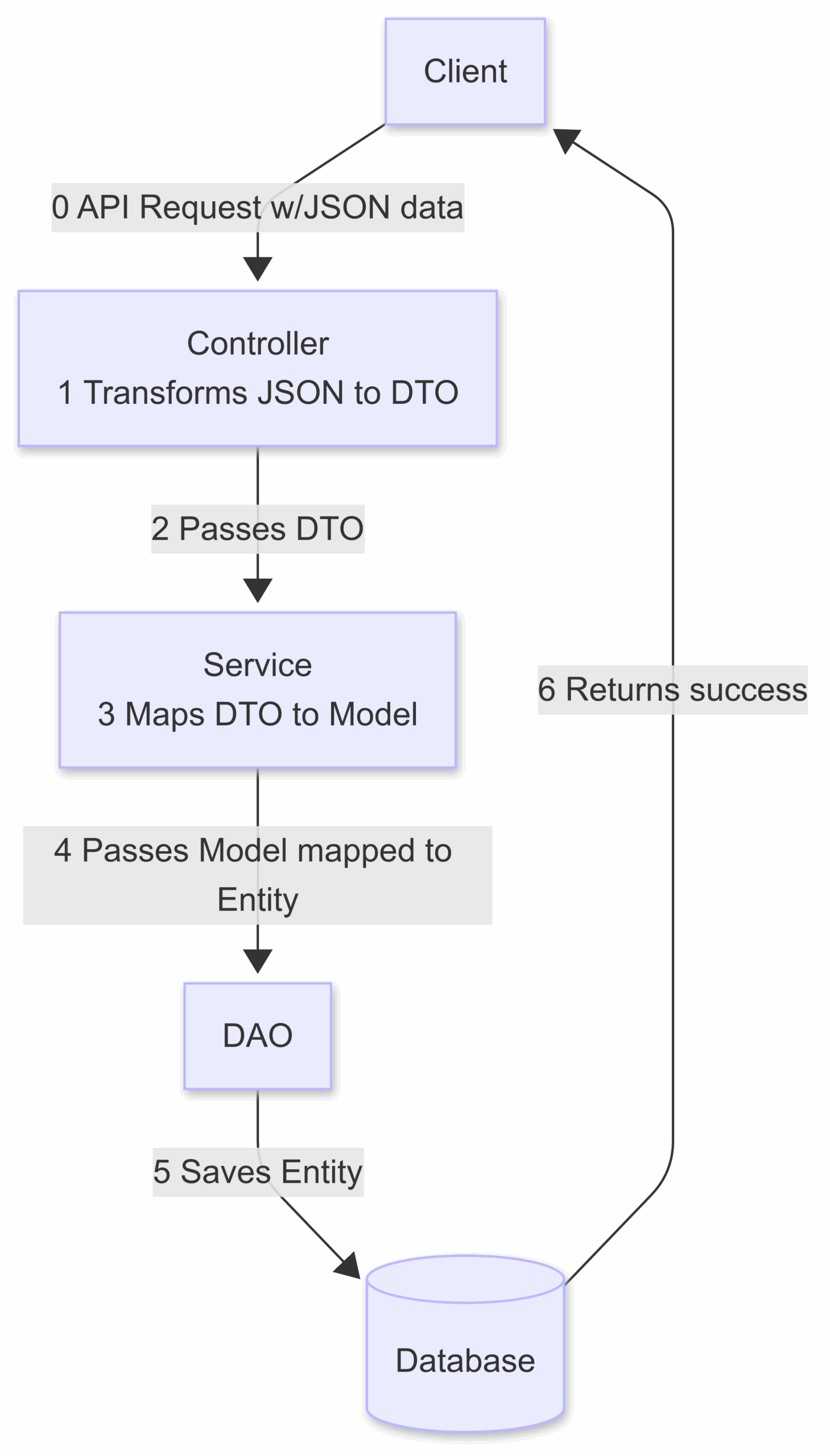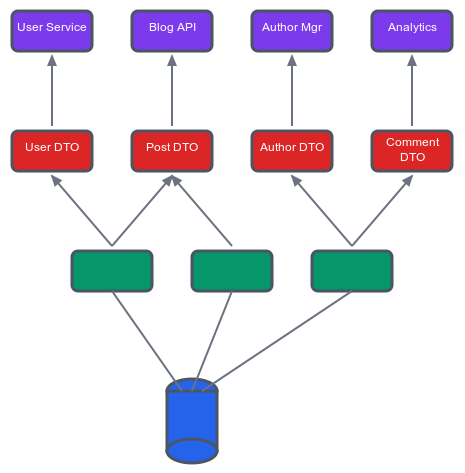There’s confusion and ambiguity in data layer terminology, especially if you are not in the habit of defining data layers of an application from the ground up. Let’s try to clear this up. Why is this important? Terminology is important to ensure a common understanding and communication of concepts so that the team is on the same track as it evolves and interacts with the data. Getting data wrong leads to bugs and inefficiencies in the application. Maintaining a clear abstract definition of data definition and organization helps to mitigate such problems.
There is often a disparity between the concrete representation and storage of data from its necessary use within the application. Let’s break down each concept by how they work together to create a data layer segregated into sub-layers with specific responsibilities.
| Concept | Layer | Primary Purpose | Key Trait |
|---|---|---|---|
| Entity | Persistence | Mirror DB structure | Contains ORM mappings (e.g., @Entity) |
| Model | Domain/Business | Enforce business rules and logic | The core “truth” of your application |
| DTO | Service/Presentation | Transfer data across process boundaries | A simple data bag with no logic |
| DAO | Persistence | Abstract DB access operations | Provides CRUD methods for an Entity |
So, to get terminology correct, we will explain the difference between an “entity” and “model” and how DTO and DAO play roles. The core difference is one of concern and context: an Entity is about the database representation, while a Model is about the business logic representation.
Entity: The Database Ambassador
An Entity is a class that is directly mapped to a database table. Its purpose is to represent the state and structure of a database record.
-
Primary Concern: Data Persistence
-
Lives in: The Data Access/Persistence Layer
-
Characteristics:
-
Each instance corresponds to a row in a table.
-
Its fields/properties map directly to table columns.
-
It often includes ORM (Object-Relational Mapping) annotations like
@Entity,@Table,@Column(in Java/JPA) or similar decorators in other languages (e.g.,[Table]in C#,@entityin Python with SQLAlchemy). -
It defines relationships (e.g.,
@OneToMany,@ManyToOne) to other entities.
-
-
Example: A
UserEntityclass with anid,username,password_hash,created_date, etc., that exactly matches theusersdatabase table.// Java (JPA) Example @Entity @Table(name = "users") public class UserEntity { @Id @GeneratedValue(strategy = GenerationType.IDENTITY) private Long id; @Column(name = "username", nullable = false, unique = true) private String username; @Column(name = "password_hash", nullable = false) private String passwordHash; // ORM Annotations, getters, and setters }
Model (aka Domain Model): The Business Brain
A Model (also often called a Domain Model or Business Model) is a class that represents a core concept of your business domain. It contains both data and the behavior (business logic) that operates on that data.
-
Primary Concern: Implementing Business Logic and Rules.
-
Lives in: The Domain Layer (the heart of the application). It is persistence-ignorant (no ORM annotations) and rich with business methods.
-
Characteristics:
-
It is persistence-ignorant; it has no knowledge of how or where its data is saved. It should not have any ORM annotations.
-
Encapsulates the business rules and logic of your application — methods that enforce business rules (e.g.,
calculateTotal(),validate(),changePassword()). -
It is the most important layer and should be the least likely to change if your database or API changes.
-
-
Example: A
Usermodel that has a methodchangePassword()which enforces password complexity rules before updating its ownpasswordfield.// Java Example - Pure Domain Model public class User { private Long id; private String username; private String password; // Might be hashed by a service, not the model itself // Business logic lives here public boolean isValidPassword(String inputPassword) { // Logic to validate password against stored hash return PasswordEncoder.matches(inputPassword, this.password); } // Getters and setters might have validation logic public void setUsername(String username) { if (username == null || username.trim().isEmpty()) { throw new IllegalArgumentException("Username cannot be empty"); } this.username = username; } // ... other getters and setters }
The Model is the “truth” of your business. The Entity is just a persistence mechanism for that model. In simpler applications, the Entity and the Model are often the same class, but this is considered an anti-pattern in complex domains because it couples your business logic to your database schema.
Data Transfer Object (DTO): The Data Courier
A DTO is a simple container for data used to move information between layers, especially across network boundaries. Its sole purpose is to reduce the number of method calls by aggregating data.
-
Primary Concern: Data Transfer, often over a network (e.g., API requests/responses).
-
Lives in: The Service Layer or Presentation Layer.
-
Characteristics:
-
It contains no business logic—only fields, getters, and setters.
-
It is often tailored to a specific use case (e.g.,
UserCreationRequest,UserSummaryResponse). -
Provides a stable, decoupled contract for external communication; used to decouple your internal domain/entity from your external API contract.
-
It protects your API from internal changes. You can change your
Usermodel’s structure without breaking your API clients, and vice-versa.
-
-
Example: A
UserDtosent to a web client that excludes sensitive fields likepasswordHashand includes a calculatedfullNamefield.// Example DTO for sending user data to a client public class UserDto { private Long id; private String username; private String email; private String fullName; // A field that might not exist in the Entity // No logic, only getters and setters public String getFullName() { return fullName; } public void setFullName(String fullName) { this.fullName = fullName; } }
Data Access Object (DAO)
A DAO is a design pattern that provides an abstract interface to the database. It hides all the intricate details of the persistence mechanism (e.g., SQL, NoSQL queries) from the rest of the application.
-
Primary Concern: Abstracting data access and persistence operations.
-
Lives in: The Data Access Layer.
-
Characteristics:
- Separates persistence logic from business logic.
-
It provides CRUD (Create, Read, Update, Delete) operations for a specific entity/model.
-
The application uses the DAO interface, not direct database calls. This makes it easy to switch databases (e.g., from MySQL to PostgreSQL) or switch from SQL to a web API.
-
In modern development, the DAO is often replaced or implemented by an ORM (like Hibernate, Entity Framework, Django ORM, Sequelize). The Repository pattern is a more advanced evolution of the DAO pattern.
-
Example: A
UserDaointerface with methods likefindById,save,delete, andfindAll.// DAO Interface public interface UserDao { Optional<UserEntity> findById(Long id); List<UserEntity> findAll(); UserEntity save(UserEntity user); void delete(Long id); } // JPA-based implementation of the DAO interface @Repository // Spring stereotype marking this as a DAO public class JpaUserDao implements UserDao { @PersistenceContext private EntityManager entityManager; @Override public Optional<UserEntity> findById(Long id) { return Optional.ofNullable(entityManager.find(UserEntity.class, id)); } // ... implement other methods }
How They Work Together in a Flow
Let’s imagine an API endpoint GET /users/{id}:
-
Presentation Layer (Controller):
-
Receives the HTTP request and extracts the user
id. -
Calls a method on a Service.
-
-
Service Layer:
-
The service contains business logic. It calls a DAO to fetch the data.
-
-
Data Access Layer (DAO):
-
The DAO (e.g.,
userDao.findById(id)) executes the database query. -
It returns a UserEntity object, which is a direct representation of the database row.
-
-
Service Layer (cont.):
-
The service might perform operations using the User model (if one exists). It might convert the
UserEntityto aUserdomain model to apply business rules. -
It then converts the result (either the
UserEntityor theUsermodel) into a UserDTO tailored for the response (e.g., hiding the password hash, formatting names).
-
-
Presentation Layer (Controller):
-
The controller receives the UserDTO from the service and serializes it to JSON to send back in the HTTP response.
-
This flow ensures each layer has a single responsibility and is decoupled from the others, leading to maintainable, testable, and flexible software.
DTOs and Models: A Flexible Relationship
DTOs closely parallel (and may even match) the corresponding data model
-
Often True, but Not a Rule: It’s very common for a DTO to initially look identical to the domain model it represents, especially for simple CRUD operations. A
UserModelmight haveid,name,email, and theUserResponseDtomight have those same fields. -
The Divergence is the Point: The power of the DTO pattern emerges when they stop matching. DTOs are tailored to the specific needs of a client or use case, while the Model is the single source of truth.
-
Combination: A
UserProfileDtomight combine data from aUserModeland aUserProfileModel. -
Omission: A
PublicUserDtomight return a user’snameandavatarUrlbut omit theiremailfor privacy. -
Addition: A
UserDtomight include a calculated field likeisEligibleForDiscountthat isn’t stored in the model but is derived from its data. -
Flattening: A
UserOrderDtomight flatten a relationship, taking theorderNumberfrom an associatedOrderModelinstead of nesting the entireOrderModelobject.
-
DTOs often start life as mirrors of Models but are expected to diverge based on external requirements. The Model is stable; the DTO is volatile and adaptable.
DAOs and Entities: A Direct Mirror
DAOs closely match the entity definitions
-
This is Almost Always True: This relationship is much more direct and rigid. A DAO’s single responsibility is to perform CRUD operations on a specific Entity.
-
One-to-One Mapping: You will typically have:
-
A
UserEntityclass. -
A
UserDaointerface (e.g.,UserRepositoryin Spring). -
The
UserDaowill have methods likesave(UserEntity entity),findUserEntityById(Long id), anddelete(UserEntity entity).
-
-
The DAO is Contracted to the Entity: The DAO’s interface is defined by the structure and relationships of the Entity it manages. Its purpose is to translate that object-oriented structure into persistence commands (SQL, etc.).
The DAO is fundamentally tied to its corresponding Entity. This is a very strong, one-to-one coupling by design.
Visualizing the Relationships
A Practical Example

Imagine an application with a User and a Order model.
-
Persistence Layer:
-
UserEntity(id, username, password_hash, created_date) -
OrderEntity(id, user_id, total_amount, status) -
UserDao– methods likesave(UserEntity),findById(id) -
OrderDao– methods likesave(OrderEntity),findOrdersByUser(UserEntity)
Here, the DAOs are tightly coupled to their respective Entities.
-
-
Business Layer:
-
Usermodel (id, username, password, ordersList, hasPasswordExpired()) -
Ordermodel (id, totalAmount, status, canBeCancelled())
-
-
API Response:
-
You need an API endpoint that returns a user’s profile along with a summary of their recent orders.
-
You would create a
UserProfileDto:public class UserProfileDto { private Long id; private String username; private List<OrderSummaryDto> recentOrders; // <- Flattened/combined data } -
This DTO does not match any single Model. It combines data from the
Usermodel and theOrdermodel and presents it in a tailored structure for the client.
-
Final Takeaway: Your intuition is spot-on for the data access layer (DAO/Entity mirroring). For the interface layer (DTO/Model), the parallelism is a common starting point, but the strategic value of DTOs is realized when they are allowed to be different from the domain models to meet external demands without polluting the core business logic.


 I use the command line a lot, even though I am on a graphical user-interface (GUI) on Windows, macOS, or Linux. And since I’m lazy, I write a lot of scripts to perform repetitive tasks. I stumbled across macOS commands that allow command line programs to copy/paste between the clipboard that we’re so used to using.
I use the command line a lot, even though I am on a graphical user-interface (GUI) on Windows, macOS, or Linux. And since I’m lazy, I write a lot of scripts to perform repetitive tasks. I stumbled across macOS commands that allow command line programs to copy/paste between the clipboard that we’re so used to using. Here’s a little recipe for printing a “call-stack” for Bash scripts. A call-stack is normally the list of nested function calls. This recipe will utilize the
Here’s a little recipe for printing a “call-stack” for Bash scripts. A call-stack is normally the list of nested function calls. This recipe will utilize the  In Rust, the most common way to parse command-line parameters is by using the
In Rust, the most common way to parse command-line parameters is by using the 
 Things evolve. ReactJS evolves. With version 16.3, there were several changes to the component life-cycle methods. In particular,
Things evolve. ReactJS evolves. With version 16.3, there were several changes to the component life-cycle methods. In particular,
Catching the Technology Train, After I’d Disembarked
Staying away from programming for too long, things change faster than I’d ever expected. Even with a strong foundation, when things move ahead so quickly, too many things change and it isn’t as easy to hop back on the train, as I would have thought. Today, I am trying to catch up with technology train that is web development. How did I become so disconnected?
The result is that, not only do I need to learn new languages and their nuances, I even need to learn a new workflow, a new way of doing programming. While I am not starting from scratch, a lot of my prior “expertise” is not directly applicable; so it feels like starting from scratch.
I could just stick to the old technologies that I am still expert at, but that isn’t cutting edge. Still I could do that. Then I wouldn’t have anything to be stressed about. And, that wouldn’t be so bad, now would it?
Posted in Commentary